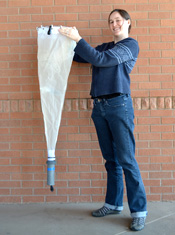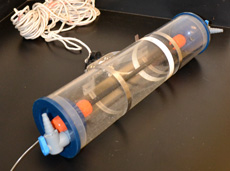show/hide words to know
Biofuel: machine fuel, like gasoline, made from living organisms instead of petroleum (oil)... more
Culture: a growing “soup” of microscopic organisms and the nutrients they need to survive.
Flask: a glass container that usually is wide at the bottom and narrow at the top and has a long neck at the opening... more
Marine: living in the ocean.
Meter: a unit of length equal to 100 centimeters or 39.37 inches. A meter is also about the same length as a yard.
Species: typically a group of organisms that are so similar that they can interbreed (have offspring)... more
Collecting Algae for the Lab
Phycologists—not to be confused with psychologists—are scientists who study phytoplankton, or algae. Some phycologists investigate what goes on inside phytoplankton cells. Others are curious about the ecology of algae; that is, they want to know what types of algae live in different places and how they affect the other creatures that live there. Still others are trying to use algae to benefit humans, such as by making algae-based biofuels.
Want to learn more about what it's like to study planktons and the ocean? Read about phycologist and oceanographer Susanne Neuer.
The Phytoplankton Store
When a phycologist needs a particular species of algae for a research project, he or she can often order it, just as you might order a specific fish from a pet store or a plant from a greenhouse.

Before a phycologist can begin to study these creatures, they need to be brought into the laboratory. Above are rows of flasks of phytoplankton cultures growing in a laboratory.
Organizations that sell algae to scientists are called culture collections because they keep many species of algae growing “in culture.” That means they grow phytoplankton in glass flasks of fresh or salt water. They give the cells plenty of light and fresh supplies of nutrients to keep them alive and growing.
People who work at culture collections have to be very careful to keep these cultures clean. If even a very small amount of bacteria or another kind of algae gets into a flask, it can quickly contaminate and ruin the entire culture.
Tools for Gathering Algae

Oceanographer Jessica Amacher demonstrates a plankton net. The net is dragged behind a boat to collect algae and zooplankton in the gray bottle at the bottom.
What if you’re a researcher who wants to study a natural community of phytoplankton? You can’t order that from a culture collection, so there’s just one option: to venture outside to a pond, lake, river, or the ocean and gather wild algae!
Some of the equipment phycologists use to collect their samples is very simple. A scientist studying the algae in a nearby lake might rent a boat, use a plastic water jug to scoop up water from the surface, and put the bottle in an ice-filled cooler to keep it cold until it can be delivered to the laboratory.
Other algae-collecting tools are more sophisticated. Researchers who study marine phytoplankton have to get water samples from 150 meters (almost 500 feet) down or even deeper. That’s way too deep to reach over the edge of a boat with a plastic bottle! Instead, they send down computer-controlled contraptions of tall, steel bottles that can withstand the pressure of deep water to collect these samples.

A deep water sampler used to collect water several meters below the surface.
When phycologists collect samples of phytoplankton, they usually also gather information about the environment or place where they got that sample. Temperature, the saltiness of the water, how much oxygen is dissolved in the water, and what the weather is like—all of these things can help scientists understand what makes different types of algae grow there and how that community of algae changes from day to day, week to week, and year to year.
View Citation
Bibliographic details:
- Article: Collecting Algae
- Author(s): Amy Hansen
- Publisher: Arizona State University School of Life Sciences Ask A Biologist
- Site name: ASU - Ask A Biologist
- Date published: April 18, 2011
- Date accessed: April 17, 2024
- Link: https://askabiologist.asu.edu/collecting-algae-lab
APA Style
Amy Hansen. (2011, April 18). Collecting Algae. ASU - Ask A Biologist. Retrieved April 17, 2024 from https://askabiologist.asu.edu/collecting-algae-lab
Chicago Manual of Style
Amy Hansen. "Collecting Algae". ASU - Ask A Biologist. 18 April, 2011. https://askabiologist.asu.edu/collecting-algae-lab
Amy Hansen. "Collecting Algae". ASU - Ask A Biologist. 18 Apr 2011. ASU - Ask A Biologist, Web. 17 Apr 2024. https://askabiologist.asu.edu/collecting-algae-lab
MLA 2017 Style

Be Part of
Ask A Biologist
By volunteering, or simply sending us feedback on the site. Scientists, teachers, writers, illustrators, and translators are all important to the program. If you are interested in helping with the website we have a Volunteers page to get the process started.










